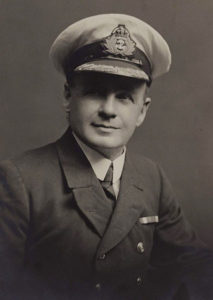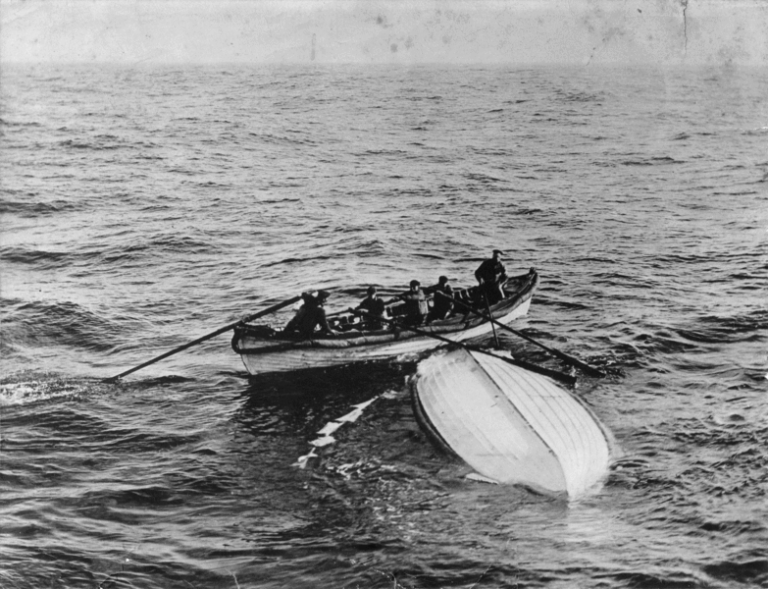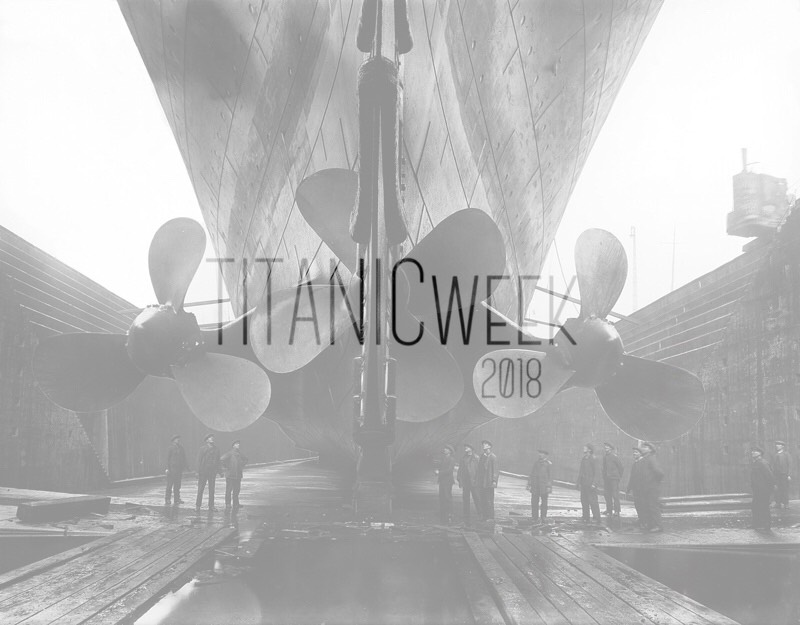"Not Damn Likely!": Second Officer Charles H. Lightoller
If there's only one way to describe Charles Lightoller, it's this: the man was a goddamned survivor.

Charles Lightoller, circa 1920s.
Charles Herbert Lightoller was born to a family of cotton millers in England; his mother died shortly after birth, and his father abandoned him to live in New Zealand. So at all of thirteen years old, Charles looked to a life at sea, because he wanted to avoid being fated to factory labor.
But after surviving a shipwreck on a desert island, a cyclone, a fire at sea, and malaria, Charles said goodbye to the sea, and tried his luck in the Yukon for the gold rush.
This plan didn't come to fruition. So he then became a cowboy.
That didn't work either, so he became a hobo, riding the train rails back across Canada.
Then he bartered passage across the Atlantic as a cattle wrangler on a cattle boat. When he got back to England in 1899, Charles Lightoller was destitute.
Then, at last, in January of 1900, he began working for the White Star Line.

A glimpse of what Lightoller's pre-Titanic career may have looked like: miners waiting to register their claims in the Klondike Gold Rush. Courtesy of the Canadian National Archives.
Lightoller signed onto Titanic two weeks before departure as First Officer, and acted in that capacity during sea trials. Captain Smith, however, renamed his Chief Officer, bumping Officer William McMaster Murdoch to First Officer, and consequently, Lightoller to Second Officer. His on-board nickname quickly became "Lights."
On the night of April 14, 1912, Lightoller was stationed at the helm for the 6:00 p.m. to 10:00 p.m. watch. He retired to bed after First Officer Murdoch reported to replace him, and he advised that the lookouts had been instructed to keep a weather eye for ice.
At 11:40, Lightoller felt a grinding motion in the ship, and ran to the boat deck in his pajamas, where he was met by Third Officer Herbert Pitman, also disturbed from sleep. But there seemed to be no alarm on the bridge, so they returned to their cabins.
But not ten minutes later, Fourth Officer Joseph Boxhall ran into Lightoller's room saying there was "water up to F Deck in the Mail Room." Lightoller threw clothes over his pajamas and reported to the bridge.

Lightoller (smoking) with Third Officer Pitman outside the Senate Inquiry.
Lightoller, a veteran of shipwrecks, took the situation seriously, but he later admitted that at the time, he did not believe the ship would founder. He took to loading the even-numbered lifeboats on the port side; Murdoch took the odd-numbered boats, starboard.
Lightoller took the "Women and Children First" decree literally, and rarely let any men aboard lifeboats--the sole exception was Major Arthur Peuchen into Lifeboat 6 because he was a yachtsman. He even tried to eject a thirteen-year-old boy from Lifeboat 4, but was persuaded by the boy's father.
Lightoller worked so fervently that despite the freezing air, he was sweating through his clothes. As the water reached C Deck, Lightoller briefly joined Dr. John Simpson, Chief Purser Hugh McElroy, and others, where Dr. Simpson teased in greeting, "Hello, Lights. Are you warm?"
In the chaos, Chief Officer Wilde found Lightoller and demanded to know where the firearms were kept. Lightoller led them to the locker in the First Officer's quarters, where Wilde slapped a gun into Lightoller's hand, insisting he might need it. Later, a group of men swarmed Lifeboat 2; Lightoller jumped in, brandished his gun, and threatened them all to get out.
With the help of Captain Smith and First-Class passenger Archibald Gracie, Lifeboat 2 was launched just before 2:00 a.m., 20 minutes before submersion; it took a mere fifteen feet for the lifeboat to hit the water.
It should have taken seventy feet.

Chief Officer Henry Wilde, who Lightoller openly defied multiple times during the sinking.
While launching Collapsible Lifeboat D, Chief Officer Wilde ordered Lightoller to accompany it. Defying his senior officer, Lightoller yelled over the melee.
I stood partly in the boat, owing to the difficulty of getting the womenfolk over a high bulwark rail just here. As we were ready for lowering the Chief came over to my side of the deck and, seeing me in the boat and no seaman available said, “You go with her, Lightoller.”
Praises be, I had just sufficient sense to say, “Not damn likely,” and jump back on board; not with any idea of self-imposed martyrdom—far from it—it was just pure impulse of the moment, and an impulse for which I was to thank my lucky stars a thousand times over, in the days to come. I had taken my chance and gone down with the rest, consequently I didn’t have to take any old back-chat from anyone.
As Lightoller was trying to free Collapsible B, Titanic plunged forward; water washed the boat deck and the lifeboat floated away upside down.
Charles Lightoller stayed on board until there was no board. This moment later served as a dramatic highlight during the American Senate Inquiry.
SENATOR SMITH: What time did you leave the ship?
LIGHTOLLER: I didn't leave it.
SENATOR SMITH: Did the ship leave you?
LIGHTOLLER: Yes, sir.
The falling first funnel almost crushed him. Then Lightoller was sucked down with the ship and pinned against a grate, but by some miracle, when there was an explosion within the ship, the force of it shot him back to the surface.
And there he found, and clung to, the overturned lifeboat Collapsible B.

Recovery of Collapsible B by the crew of the Mackay-Bennett.
About thirty men, many crew, found their way onto the hull of Collapsible B. The boat was already partially submerged, so Lightoller immediately took charge.
At Lightoller's direction, the men each balanced on its back, staggered and moving this way and that, to keep it functionally above water as the air bubble beneath it diminished. Harold Bride, the junior Marconi operator, even suffered frostbite to one foot for it, and his other foot was crushed in the lifeboat's mechanisms.

Junior Marconi operator Harold Bride being carried off Carpathia due to injuries to his feet sustained on Collapsible B. Courtesy of Library of Congress.
Throughout the night, Lightoller called out the names of potential rescue ships to try to bolster the other survivors.
Still, one by one, men died.
The men on Collapsible B united in rounds of prayer. Around dawn, after Lightoller relentlessly blowing on his whistle for other lifeboats to come about, Lifeboats 4 and 12 approached, and the remaining survivors of Collapsible B were transferred to safety.
There is still debate about who may have lived and died on Collapsible B.
Second Officer Charles Lightoller was the very last Titanic survivor to board Carpathia, only after having ensured that all surviving passengers and crew were secure on deck.

Tthe surviving officers of the sinking of the Titanic (Lightoller center, standing.)
Charles Lightoller was the highest ranking officer to survive Titanic's sinking, and testimony at the subsequent inquiries was vital, especially as he was not only testifying, but also defending himself, his employer, and his departed crewmates.
Lightoller went on to serve in the First World War, during which he was awarded with both the Distinguished Service Cross and the Reserve Decoration, and was promoted to Commander.
He saw combat again in World War II, when he crossed the English Channel to aid the Dunkirk evacuation, rescuing over 120 soldiers in his yacht, called "Sundowner." On the way back, Commander Lightoller encountered enemy aircraft and was attacked with gunfire, which he miraculously evaded thanks to a technique he had learned from his youngest son, who was R.A.F. and had been killed in action in 1939.
Still, Lightoller--like most surviving crewmembers--found that Titanic was still a black mark on his record, and encountered financial difficulties. Lightoller went on to try his hand at property speculation, boatyard management, inn-keeping, and chicken farming.
In 1934, he released his autobiography at the insistence of his wife.
Charles Lightoller died at 78 years old.
share
